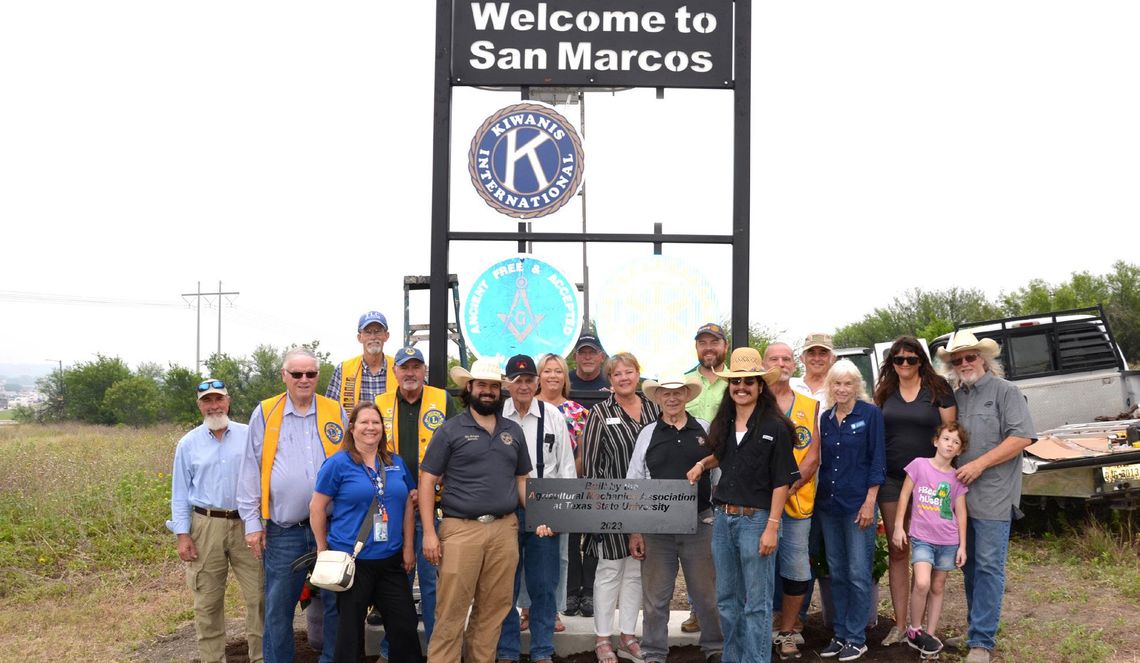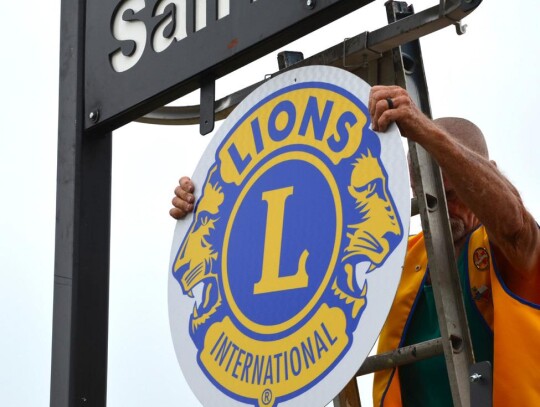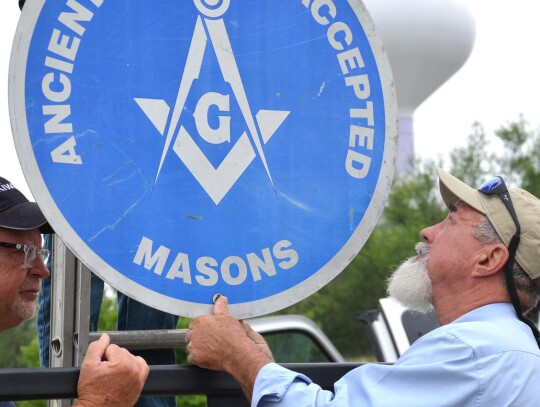A group of key nonprofits in the city banded together to replace the dilapidated “Welcome Sign” located on SH 123 on Thursday and at the same time, update their individual signs of welcome posted there.
Representatives of the Lions Club, the Rotary of San Marcos, the Freemasons and the San Marcos Kiwanis Club gathered at the sign site, materials in hand, ready to make a change in what visitors see coming into the city, but also, what is not seen: a better working relationship among these organizations. That day, each organization replaced their 30-inch disk that had faded and grown shopworn. Also on tap to be replaced was the 2-inch pipe framing that had rusted over the decades.
The sign they were getting ready to replace has helmed that location since the 1950s although no one on Thursday was quite certain how old it was and who put it up.
As part of its 100th anniversary year, the Kiwanis had identified replacing their club disk, and thought perhaps the other clubs with signs might want to consider putting up something new.
These service clubs sent representatives to a first meeting where each talked about upcoming plans and how they could encourage and support one another through a more coordinated approach to scheduling and project management.
At that meeting, the Kiwanis learned that the Lions Club had also been contemplating that very project.
A preliminary design that could incorporate the logos of each club on a larger welcome sign was drafted and the clubs reached out to Texas State University Agricultural Mechanics Program instructor Brad Borges and some of his students to take the concept forward. A revised design incorporated the welcome phrase and the four club disks.The near completed main sign was moved from the campus to an intermediate location where it was painted by Kiwanis club members.
The creation of the new sign became a reality with necessary donations provided by several individuals and sweat equity from club members who removed the old rusted frame and cleared a tree and brush at the site.
Ryan Lackey of Lackey Boys Concrete installed rebar and anchor bolts, as well as formed and poured a concrete foundation to support the new structure.
The concrete was donated by Ingram Ready Mix. Ewald Tractor provided the auger used to drill the holes for the foundation, and Chase Dame provided a crane to lift the frame onto the foundation.
Kiwanis Board Member Lon Shell Sr., said that this was not an inexpensive effort and without the help of those donations would have been a financial burden for the nonprofits.
He said each club pitched in $500, while the remainder of the materials, equipment and labor were provided by other members of the community.
“The materials and so forth, to pay the university and the students, and the painting was about $2,000. The actual cost is $2000, but then the donations were the concrete, raising it, and all of the other [work that went into it] probably would have cost about $4,000,” Shell said.
Shell said the donations ensure that the majority of funds raised annually by these nonprofits can still go to assist youth and others here, as intended by their individual missions.
“Ninety percent of all of the funds we raise go to youth,” he said.
Each of these organizations regularly host activities and events to raise those funds.
Incoming Lions Club President Mike Smith said that his club’s tube rental, known to locals and guests alike, started in the back of a cattle truck 40 years ago. He said the club has had a presence in the community for 82 years.
“They inherited a lot of the land around City Park. We had a building over there. We met over there, and City Park is a result of Lions [Club] giving up some of the land,” Smith said. “The Lions are the number one, nongovernmental humanitarian organization. We’re in 210 countries worldwide.”
Lions Club Board of Directors member Stephen Traeger shed light on the purpose of his organization.
“Our motto is ‘We Serve,’ and as you probably know our biggest fundraiser is the tube rental. We raise over $300,000 [a year] and give all of that back to the community. Our charter requires that anything we collect from the public has to go back to the public. Our administrative expenses are all covered by our dues.
'We can’t use anything we generate from the public to pay our administrative expenses. Anything from the tube rental goes back to the community, from the shelters to the youth organizations– everything,” Traeger said.
Smith said the tube rental business is not the only way that the organization gives back to the community.
“For diabetes, this coming year–we’re pushing for November–we’re going to have a Lions Stride Walk. We’ll have people checking sugar [levels] and blood pressure and all of that. We’re using City Park for that because you have to have a place to conduct a 30-minute walk,” Smith said. “We may have a Lions Charity Auction, and we want to make that an annual thing.”
Shell said he had a hand in bringing some of the club leaders together.
“Kiwanis is celebrating their 100th Anniversary, and we thought this would be a good event to get all four clubs to do this,” Shell said. “Now as we got together, we found out that the Rotary had celebrated their 100th [Anniversary] the year before.”
Shell said that sign maintenance was not the only beneficial reason for the nonprofits to work together.
“We [Kiwanis] have a camp on the Blanco River by Five Mile Dam that we provide … to youth all over the state–free of charge. And I’m sure these other clubs work with youth. We want to invite their leaders out to our camp someday, and say, ‘Look, you have access if you want to invite youth and use the camp, you certainly can,’” Shell said. “I think they could get involved and take advantage of what we’re doing out there.
'I think they have activities that we could take advantage of, and there’s no reason for four clubs doing the same thing. We don’t have to stack on top of each other.”
Past Master of Freemasons Sonic Lodge #342 John Tolbert said that their lodge recently turned 150 years old, but the club itself has a much longer history in the town, as its first lodge was chartered in 1853.
“The first lodge was called Cushnie Lodge,” Tolbert said. “To think that people actually started a fraternal organization and kept it going when people were living in log cabins, and it was hard just to survive, it’s pretty amazing.”
Tolbert said Cushnie Lodge is now a historical home located on 1030 Belvin St.
“It’s the fanciest house in town. It’s this Italian Renaissance [style home] with a carriage house,” Tolbert said. “The Johnson family, which were very wealthy, they bought the house from somebody who went bankrupt–cotton growers– and then they got into financial trouble in the 1930s. … The lodge members at that time, some of them were bankers and other stuff like that, bought the building for $10,000, which was a lot of money, from that family.
'The lodge was there until 1992. And unfortunately, they just didn’t have enough money to maintain it. The roof was leaking and had problems, so they sold it for a couple hundred thousand dollars. We got a metal building down the road. Now it’s really nice on the inside, you would never know. I remodeled the whole thing–6,000 square feet, but it's got wood paneling and curtains.”










